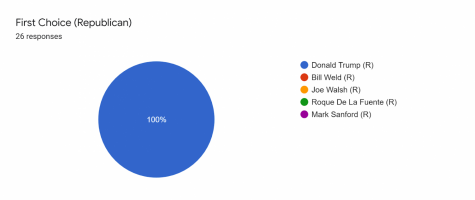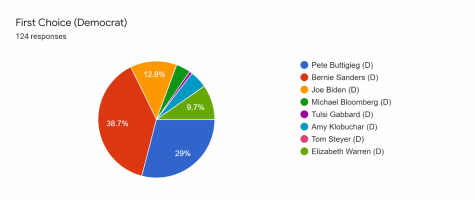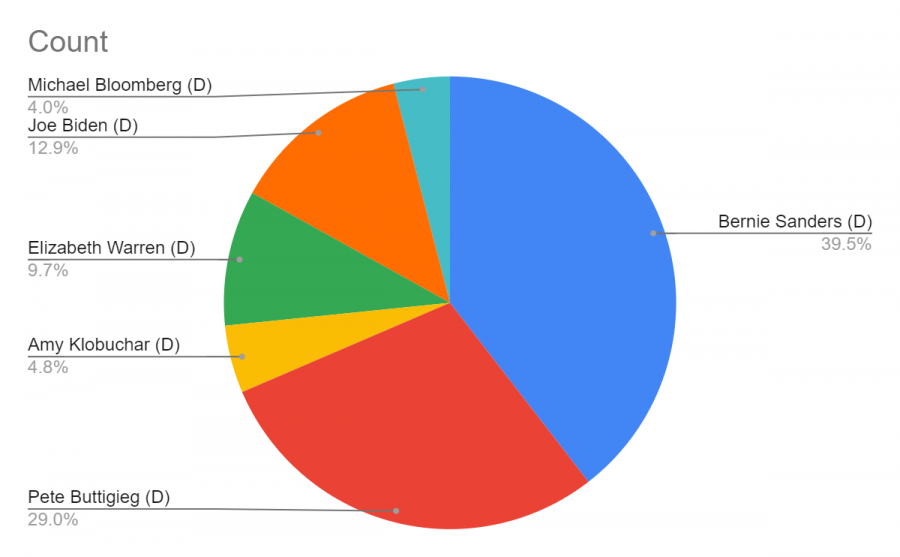Ranked-Choice-Voting has the potential to improve elections
March 12, 2020
Voting can be a complicated affair. There are a variety of overlapping jurisdictions and legislatures, each with their own nuanced methods of democratic election.
There are multiple systems of voting. Most elections in the United States use a variation of the “First-Past-The-Post,” system. In the most basic form of this voting system, each citizen gets one vote and the candidate with the most votes wins.
This voting system, however, is not the only one. A possible alternative is the “Ranked-Choice-Voting” system. In this system, each voter would be allowed to number the candidates in order of their preference. Should their first choice receive too few votes to win, their vote would go to their second choice. This process would continue until a candidate had a majority of the votes.
Pros and Cons
There are pros and cons to each system.
America’s current system is relatively simple and easy to use for a voter. They only need to select their top choice.
Under this style of voting, “viability” can be an important factor in elections. Voters must weigh the odds of their preferred candidate winning. If they do not believe enough other voters will choose them, it may seem like voting for them would be a waste. If two candidates have similar ideals, voters may pick the one they believe is more likely to win rather than the candidate they prefer. If they don’t, they risk “splitting the vote,” i.e. dividing one group’s votes between candidates, allowing an opposing group to win. This was a contributing factor in the 2016 election, when the Democratic vote split between Hillary Clinton and Bernie Sanders.
This style of voting typically leads to a two-party system because of these concerns. The two-party system comes with its own complex set of pros and cons. Some believe it limits the choices of the voter and encourages partisanship, while others believe that it forces people to think of the bigger picture and make reasonable compromises instead of arguing about small differences. This may be a point in its favour to some and a point against to others.
However, in cases where a two-party system does not arise or a third party gains enough momentum, there is a risk that a candidate will be elected to office with less than half of the votes. This can happen because, under the voting system, a candidate needs the most votes, not a majority of the votes. If there are three candidates running, and two get 30% of the votes, and the third gets 40% of the votes, the third candidate would win. They had the most votes, even though less than half of voters selected them.
Elections in the United States have a variety of safeguards for these situations. Perhaps the most notable example is the Electoral College system. One facet of the system is the requirement that a candidate must get a majority (270) votes in order to win. If no candidate accrues enough votes, the House of Representatives has the responsibility of choosing the president. Though the Electoral College is complicated and controversial, it is one method of overcoming this particular flaw in the current voting system.
Read more on the Electoral College: Tennessee Representative introduces bill to end electoral college
The possible alternative voting system explored here is more complicated. There is a risk that it might be harder for voters to use. It would also require a longer time to determine the results of the election. After all the votes were in and counted, the “Instant Run-Off” would have to begin. (This is another name for this voting system). Essentially, the process of eliminating the candidates with the least votes and redistributing those votes to the voter’s next choices would add a delay. With current technology, however, it would be manageable.
Under this system, voters would not have to worry about candidate viability, as they could pick their top choice first and put other candidates as second or third choices. It would eliminate the risk of splitting a vote.
This voting system does still typically lead to a two-party system, as the major party candidates tend to represent the most mainstream version of their side’s beliefs and thus are acceptable to enough people to gain the required votes. There are, of course, exceptions. Under this system, there would be more flexibility for a third party to gain in a specific election if a party’s chosen candidate does not suit the constituency. It allows for the positives that can come from the two-party system while deemphasizing the negatives. For these reasons, the first round of votes is often viewed as the most accurate desires of the voters and can be good data to go forward with.
Because the voting system requires that a candidate get a majority of the votes, there is no risk of a candidate being elected with less than half of the votes. Every elected candidate should be a candidate that at least 50% of voters agree they would be content having in office, as voters need not number every candidate.
Student Poll Results
A number of student concerns were with the format of the poll itself, such as suggestions that the poll be updated with accurate candidates. This was an issue because removing options after some responses had already been submitted could cause issues with data. For this reason, the poll includes every candidate who was running when it was posted on Feb. 24. There was also an error during the first few days of the poll where voters were required to pick a name for each choice. This is not how the system is meant to work and was corrected.
Some students also had concerns about the security of it. Any actual primary, regardless of the voting method, would use official security measures. Another concern was the fact that the poll only included the Republican and Democratic parties. This decision was made because of the Illinois primary system. In a general election, however, all eligible candidates, regardless of party, would be on the ballot.
The poll received 150 responses in total. 124 of them were for the Democratic primary, and 26 were for the Republican primary.
Here are the first choice results:


The Democrats were far more divided than the Republicans. Because a Republican candidate received more than 50% of the votes in the first round, no further candidate eliminations were necessary. Donald Trump recieved the nomination from the Neuqua Republican participants.
No Democratic candidate received more than 50% of the vote in the first round, and that’s where the second choices come in. Because Tulsi Gabbard received the fewest votes, she was eliminated. Her votes went to those voters’ second choices.
As demonstrated above, the lowest ranking candidate is eliminated until one candidate has a majority. In the Neuqua poll, Bernie Sanders won the Democratic nomination.
Student Poll Comments
Though the majority of students did not leave comments, most who did were pleased with the “Ranked-Choice-Voting-System.” Some simply said, “it’s good,” while others described their preferences in more detail, saying, it was, “effective,” “inclusive,” and “accurate.” A few however, didn’t like it, commenting “stupid,” and “it bad.”
Some suggested limiting the number of options to avoid overwhelming voters, and a number said they struggled to distinguish between candidates beyond their first few choices. One did suggest including information on each candidate for the voter, however, this could be biased and sway voters in the polling station — something most states work to prevent.
One complaint made a few times was that a voter could pick the same candidate for every choice. This is true, however, it isn’t a bad thing. Picking a candidate for multiple ranks won’t boost their chances. Once a candidate has been eliminated, votes don’t go to them. Picking the same candidate for every rank is essentially the same as only selecting a first choice. It doesn’t affect the system beyond preventing your vote from moving if your candidate is eliminated.
A number of students left comments that seemed to pertain to the current voting system rather than the new proposed model, expressing frustration with the Electoral College and the legal voting age. Although a new voting system would not directly change either of those things, it could improve the system over all, making it easier for changes supported by the majority of people to be made.
Other students simply commented on the candidates themselves, saying things like “Donald Trump,” “i hate bloomberg,” “rip yang,” and “(in my best bernie sanders impression) FREE. MEDICARE, FOR ALL.”
Thank you to all the students who participated and gave a potential system a try. Although “Ranked-Choice-Voting,” is not perfect, it seems to have the potential to help eliminate some of the flaws of our current system. It is used in a number of places, including Australia, the Republic of Ireland, Hong Kong, Malta, Zealand and others.


